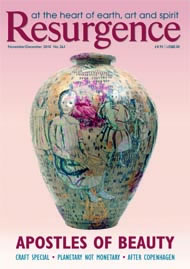Artists and artisans are alchemists. They transform base material into objects of beauty, utility and delight. Whether the alchemists of old turning base metal into gold is a literal truth or a metaphor is still debated, but there is no doubt whatsoever about the transformative power of artists and artisans.
For millennia, potters have taken a lump of ordinary clay and revealed its extraordinary ability to be a pot of pure visual pleasure as well as a vessel to fulfil everyday functions of holding water and wine, food and flowers.
Similarly, painters take pigments of red, blue and yellow of no great distinction, and put them on a pot or paper, on a wall or a canvas, and we witness the emergence of a great work, be it folk art or fine art.
Materials used by the vast number of potters, painters, sculptors and basket makers are often inexpensive, natural and locally available.
It is the power of patience and practice, the power of imagination and endurance, the power of our own hands, feet and voice, the power of the human spirit that transforms willow wands into baskets, stone into sculptures, wood into wardrobes, sounds into songs and words into poems. The joy of it all is that we are all potential alchemists. We are all capable of becoming artists and artisans.
As the maker transforms clay into a pot, the clay transforms the maker into a potter. The capacity of clay to transform ordinary and unformed humans into evolved and self-realised sages like Bernard Leach and Lucie Rie is unquestionable. If there was no clay there would be no Cardew, if there was no paper or colour purple there would be no Picasso, if there were no flowers there would be no Vincent Van Gogh or Georgia O’Keeffe. As the artist is an alchemist transforming the ordinary into the extraordinary, so too does the material bring about the metamorphosis of the maker.
I have used the terms ‘artists’ and ‘artisans’ together, as I have used ‘folk art’ and ‘fine art’, because all artisans are artists, as all artists are skilled in their crafts. The distinction between arts and crafts is divisive and derogatory. Arts and crafts are identical twins: they belong together. Henry Moore was no less a craftsperson than Lucie Rie, and Lucie Rie was no less an artist than Henry Moore.
Being an artist or an artisan is not a hobby: it is a livelihood. Moreover, a craft economy is a truly sustainable and resilient economy; indeed, a peace economy. The sooner we embrace the arts and crafts as an integral part of our daily lives, the sooner we will be able to address the economic, environmental and spiritual issues of our time. The industrial economy is a growth economy – never enough and never satisfied – whereas the craft economy is a dancing economy – always active and always joyful.
The way to a fulfilled life is through the arts and crafts. They lead us out of consumerism. The practice of arts and crafts is a spiritual practice through which we honour the material world, and while we do that we develop a sense of beauty and generosity in our lives.








